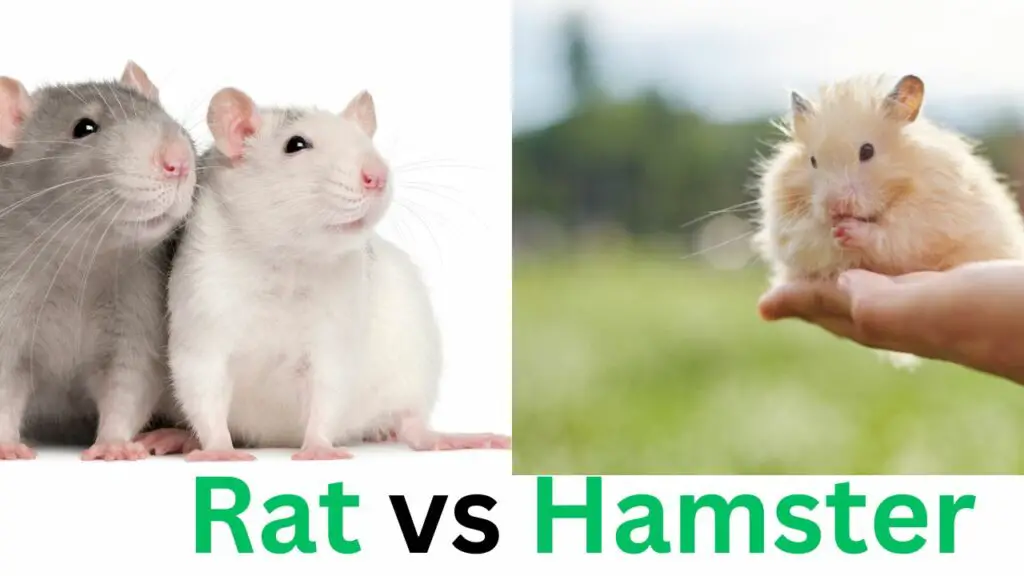Are you looking for a new furry friend to add to your family? Hamsters and rats are two of the most popular choices for small pets.
But which one is the better choice? As someone with personal experience owning both hamsters and rats, I’ll break down the differences between the two to help you make an informed decision.

Appearance and Physical Characteristics
Hamster
Hamsters are small, typically only 4-6 inches in length, and have a round, chubby body. They come in a variety of colors and patterns, including golden, white, and black. Hamsters have short legs and small ears. They are known for their cheek pouches, which they use to store food.
There are a total of 5 domesticated hamster species, all with their own unique characteristics and appearances. The most popular is the Syrian Hamster but dwarf hamsters are also getting more popular recently.
Rat
Rats are larger than hamsters, usually around 9-11 inches in length. They have a long, slim body and sleek fur. Rats come in a variety of colors, including white, black, and brown. They have long tails and large ears. Rats are also known for their intelligence and dexterity.
All rats are of the same species, which is the Fancy Rat. However, there are many different varieties such as:
- The Dumbo Rat – characterized by its dumbo ears
- The Rex Rat – a curly-haired variant
- Satin Rat – characterized by its silky coat
- The Hairless rat – a rat without hair, as the name suggests
- Bristle Coat Rat – has a rough, bristly coat
Temperament and Behavior
Hamster
Hamsters are generally solitary animals and prefer to be alone. They are crepuscular and tend to sleep during the day, so they may not be as active when you’re awake. Hamsters can be territorial and often do not get along with other hamsters. They are also more likely to bite, especially dwarfs.
Rat
Rats are social animals and enjoy being around other rats. They are intelligent and can even learn tricks.
Rats are active during the day and enjoy playing with toys and exploring their environment. They are generally friendly and rarely bite.
While hamsters can be kept alone, rats should never be housed solitarily. They need to be housed in groups or pairs otherwise they get bored and lonely.
Housing and Environment
Hamster
Hamsters are best kept in cages with plenty of room to move around. They need bedding to burrow in, and a wheel to run on. Hamsters are sensitive to temperature changes and should be kept in a warm, draft-free environment.
Rat
Rats also need plenty of room to move around, but they are more active and need more stimulation than hamsters.
They enjoy climbing and need a cage with multiple levels. Rats also need bedding and a wheel, but they also benefit from toys and objects to play with, such as tunnels and hammocks.
Training and Socialization
Teaching tricks and commands
Both hamsters and rats can be trained to do tricks and follow commands, but rats are generally more receptive to training.
Hamsters
Hamsters can also be trained, but they are generally slower learners and may require more patience and persistence.
Rats
Rats can be taught to respond to their name, come when called, and perform various tricks, such as fetching objects and climbing obstacles.
Interacting with Humans and Other Animals
Hamsters
Hamsters and rats are social creatures that enjoy interacting with humans and other animals. Hamsters can be affectionate and enjoy being held and petted, but they may also bite and scratch if they feel threatened or scared.
Rats
Rats, on the other hand, are generally more friendly and enjoy interacting with humans and other rats. They can also be trained to interact with other animals, such as cats and dogs.
Diet and Nutrition
Hamster
Hamsters are omnivores and need a balanced diet of both protein and vegetables. They also enjoy treats like fruits and seeds, but these should be given in moderation to avoid obesity.
Rat
Rats are also omnivores and need a balanced diet of protein and vegetables. They also benefit from treats like fruits and seeds, but again, these should be given in moderation. Rats can also get bored with the same food every day, so it’s important to offer variety in their diet.
Health and Care
Hamster
Hamsters are generally healthy animals, but they are prone to certain health issues like dental problems and respiratory infections. They also need regular nail trimming.
Rat
Rats are also generally healthy, but they are prone to certain health issues like tumors and respiratory infections.
They need regular nail trimming. Rats also need mental stimulation and exercise to prevent boredom and obesity.
Cost and Availability
Hamster
Hamsters are relatively inexpensive to purchase, usually costing around $10-$20. They are also widely available at pet stores and online.
Rat
Rats are slightly more expensive than hamsters, usually costing around $20-$30 if you buy them from a breeder. From a pet store, they’re often much cheaper though you’re likely to get an unhealthier rat.
Conclusion
Both hamsters and rats make great pets, but they have their differences. Hamsters are best for those who prefer a solitary, low-maintenance pet, while rats are best for those who want a social, intelligent pet that requires more attention.
Ultimately, the decision between a hamster and a rat comes down to personal preference and lifestyle. Whatever you choose, make sure to provide your new pet with a loving and caring environment.
- How Long Do American Eskimo Dogs Live? Important Factors and Care Tips - September 29, 2023
- Do American Bulldogs Need Grooming? Essential Tips and Care Guidelines - September 29, 2023
- Do Bengal Cats Enjoy Playing? Essential Tips for Keeping Them Active - September 29, 2023